What is a Boot Stripe?
The Boot Stripe is a narrow stripe that runs the length of the boat and is usually positioned a few inches above the waterline. The stripe provides an aesthetic touch and creates an optical illusion that makes the boat appear to be longer. It also gives the boat a nice “finished” appearance that many boaters take pride in. Boot stripes also define the separation between anti-fouling paint (below) and the topside paint (above). Vinyl boot stripe tape is available in different widths, colors, and designs, but unless the boat has a flat, slab side this will make the boat appear to sag or squat in the water. Painting the boot stripe on the hull allows the width to change with the geometry of the boat and give the finished stripe a uniform look. Repainting an existing Boot Stripe will be easier than starting from scratch since you won’t have to mark and score the stripe.
Find and mark the Boot Stripe. The boot stripes of many fiberglass hulls are cast into the hull from the mold by the manufacturer. They can only be removed if you sand down to the fiberglass.
If there is no stripe on your hull you will need to mark the waterline on your boat and transcribe it up to the desired height of your stripe. This can be done by applying successive layers of masking tape along the waterline curve. There are other numerous methods worth investigating online. Also, consult a professional and ask them questions about your specific boat.
Mask off the stripe with tape and get within 1/32nd in. to the edges of the old stripe. This will allow you to sand to the very edge of the old stripe, and avoid damaging the surrounding gel coat.
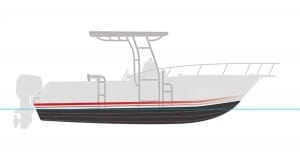 De-wax the stripe area using a de-waxing solution and a rag.
De-wax the stripe area using a de-waxing solution and a rag.
Sand only the stripe area with 220 grit sandpaper. Once sanding is complete, remove the masking tape and wipe the area with acetone. This will remove any remaining adhesive and sanding remnants. Sacrificing the first mask will contribute to a sharper finish. It is possible that the first application of tape can transfer sanding residue to the paint and result in a poor finish. Mask twice and you will only have to paint once! Be sure to take your time with the second masking. Remember: If the stripe doesn’t look good in tape, it will look even worse once painted. Now you’re ready to paint!
What type of paint should I use?
There are many different varieties of topside paint suitable for painting a boot stripe, but we have narrowed it down to just a few options for you.
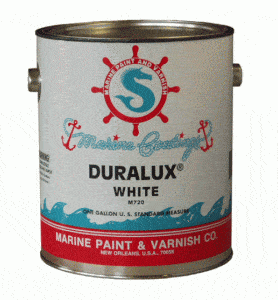 Good: Duralux Marine Enamel – Easy to use and economically viable. When applying this marine enamel to fiberglass, no primer is needed. Simply wipe the surface with acetone before and after sanding, then apply your paint. For aluminum, apply one coat of primer and follow with 2 coats of paint. This high gloss enamel will create a bright and colorful boot stripe on any vessel.
Good: Duralux Marine Enamel – Easy to use and economically viable. When applying this marine enamel to fiberglass, no primer is needed. Simply wipe the surface with acetone before and after sanding, then apply your paint. For aluminum, apply one coat of primer and follow with 2 coats of paint. This high gloss enamel will create a bright and colorful boot stripe on any vessel.
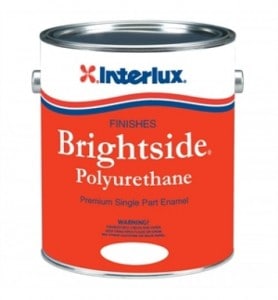 Better: Interlux Brightside or Blue Water Mega Gloss– These are a one part Polyurethane with a crisp, high gloss appearance. More durable than regular enamels, but just as easy to apply! If you are applying Brightside or Mega Gloss to fiberglass, make sure the surface is clean and in good condition. Application of Mega Gloss Water: blast surface to remove all loose paint, dirt, oils and grease. Abrade with 240 grit dry sandpaper or equivalent. Solvent wipe down to remove all sanding residue. Prime with Mega Gloss Primer for best results. For Brightside, remove wax and other contaminants using Fiberglass Solvent Wash 202 and then sand with 220-320 grit paper. Apply Pre-Kote. Brightside offers excellent flow and gloss retention especially for painting a boot stripe.
Better: Interlux Brightside or Blue Water Mega Gloss– These are a one part Polyurethane with a crisp, high gloss appearance. More durable than regular enamels, but just as easy to apply! If you are applying Brightside or Mega Gloss to fiberglass, make sure the surface is clean and in good condition. Application of Mega Gloss Water: blast surface to remove all loose paint, dirt, oils and grease. Abrade with 240 grit dry sandpaper or equivalent. Solvent wipe down to remove all sanding residue. Prime with Mega Gloss Primer for best results. For Brightside, remove wax and other contaminants using Fiberglass Solvent Wash 202 and then sand with 220-320 grit paper. Apply Pre-Kote. Brightside offers excellent flow and gloss retention especially for painting a boot stripe.
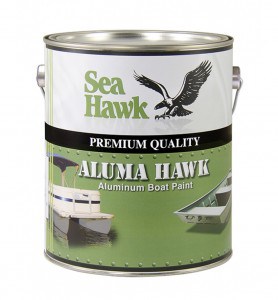 is an effective water barrier and universal primer. When applied to metal hulled boats it can serve as corrosion protection below the waterline. Therefore many boaters want to have that sort of protection on their Jon boat and apply Aluma Hawk Boat Paint on top. Aluma Hawk is an aluminum boat paint that is one of the easiest and most popular paints for aluminum boats. It is a quick-dry, high-solids, corrosion-inhibiting coating designed for use on an aluminum surface without the need for additional primers. It is chromate-free and may be used above or below the waterline in fresh or saltwater environments. You can paint Aluma Hawk with a brush, roller, or spray. Apply 2 coats following the proper dry time requirements. No sanding is necessary between coats of Aluma Hawk if less than 48 hours between coats. Thinning: thin if necessary with MEK.
is an effective water barrier and universal primer. When applied to metal hulled boats it can serve as corrosion protection below the waterline. Therefore many boaters want to have that sort of protection on their Jon boat and apply Aluma Hawk Boat Paint on top. Aluma Hawk is an aluminum boat paint that is one of the easiest and most popular paints for aluminum boats. It is a quick-dry, high-solids, corrosion-inhibiting coating designed for use on an aluminum surface without the need for additional primers. It is chromate-free and may be used above or below the waterline in fresh or saltwater environments. You can paint Aluma Hawk with a brush, roller, or spray. Apply 2 coats following the proper dry time requirements. No sanding is necessary between coats of Aluma Hawk if less than 48 hours between coats. Thinning: thin if necessary with MEK.
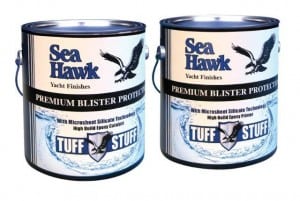

 De-wax the stripe area using a de-waxing solution and a rag.
De-wax the stripe area using a de-waxing solution and a rag. Good:
Good: Better:
Better: